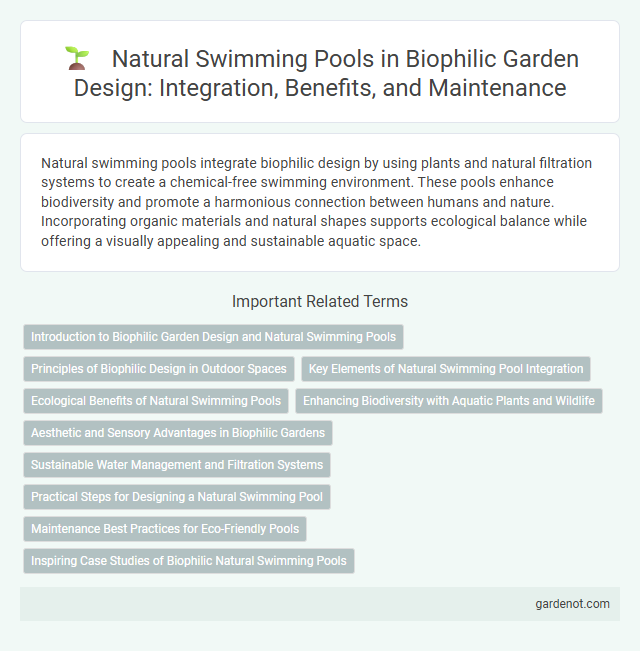Natural swimming pools integrate biophilic design by using plants and natural filtration systems to create a chemical-free swimming environment. These pools enhance biodiversity and promote a harmonious connection between humans and nature. Incorporating organic materials and natural shapes supports ecological balance while offering a visually appealing and sustainable aquatic space.
Introduction to Biophilic Garden Design and Natural Swimming Pools
Biophilic garden design integrates natural elements to create harmonious outdoor spaces that enhance wellbeing and biodiversity. Natural swimming pools use organic filtration systems with plants and biological processes, avoiding chemicals and creating a sustainable, eco-friendly water environment. These pools exemplify how biophilic principles foster a direct connection to nature while providing functional and aesthetic benefits.
Principles of Biophilic Design in Outdoor Spaces
Natural swimming pools integrate biophilic design principles by using ecological filtration systems and native plants to create a harmonious outdoor environment that enhances human well-being through direct contact with nature. These pools mimic natural aquatic ecosystems, promoting biodiversity and improving water quality without chemicals, which aligns with the biophilic emphasis on sustainability and sensory engagement. Incorporating features such as varied textures, natural materials, and organic shapes fosters a sense of connection to the natural world while supporting mental restoration and physical health.
Key Elements of Natural Swimming Pool Integration
Natural swimming pool integration relies on key elements such as a regeneration zone filled with aquatic plants that naturally filter and purify water, eliminating the need for chemical treatments. A carefully designed balance between swimming and plant zones ensures ecological stability and enhances water quality. Incorporating native plant species and sustainable filtration systems optimizes biodiversity while maintaining crystal-clear, chemical-free swimming environments.
Ecological Benefits of Natural Swimming Pools
Natural swimming pools enhance biodiversity by creating habitats for aquatic plants and microorganisms, promoting a balanced ecosystem without harmful chemicals. These pools improve water quality through biological filtration, reducing energy consumption compared to conventional chlorinated pools. The integration of native vegetation around the pool supports local wildlife and contributes to natural water purification processes.
Enhancing Biodiversity with Aquatic Plants and Wildlife
Natural swimming pools enhance biodiversity by integrating a diverse range of aquatic plants that act as natural filters, improving water quality without chemicals. These pools create habitats for various wildlife species, including insects, amphibians, and birds, supporting local ecosystems. The synergy between plants and wildlife fosters a balanced, self-sustaining environment that exemplifies biophilic design principles.
Aesthetic and Sensory Advantages in Biophilic Gardens
Natural swimming pools enhance biophilic gardens by seamlessly integrating clear, chemical-free water with indigenous plants, creating a visually captivating and ecologically balanced environment. The lush aquatic vegetation and natural filtration systems provide soothing textures and sounds, enriching sensory experiences while promoting biodiversity. These pools offer aesthetic harmony with surrounding landscapes, fostering relaxation and connection to nature through organic shapes and vibrant aquatic life.
Sustainable Water Management and Filtration Systems
Natural swimming pools utilize sustainable water management techniques by integrating biological filtration systems such as aquatic plants and gravel filters to maintain water clarity without chemical treatments. These pools rely on a balanced ecosystem where microorganisms break down impurities, promoting eco-friendly and low-maintenance water purification. Incorporating rainwater harvesting and recirculation systems further enhances water conservation, aligning with biophilic design principles for environmental harmony.
Practical Steps for Designing a Natural Swimming Pool
Incorporate a multi-zone filtration system combining biological and mechanical processes to maintain water clarity without chemicals in a natural swimming pool. Select native aquatic plants for the regeneration zone, ensuring effective nutrient absorption and enhanced biodiversity. Design the pool shape with gradual slopes and varied depths to support diverse flora and fauna while optimizing swimmer safety and comfort.
Maintenance Best Practices for Eco-Friendly Pools
Natural swimming pool maintenance emphasizes biological filtration, using plants and beneficial microbes to maintain water clarity without chemicals. Regular monitoring of water quality parameters such as pH, dissolved oxygen, and nutrient levels ensures a balanced ecosystem that supports aquatic life. Seasonal pruning of vegetation and removal of organic debris prevent algae overgrowth and sustain the pool's eco-friendly function.
Inspiring Case Studies of Biophilic Natural Swimming Pools
Natural swimming pools like the one in Vienna's Oberlaa district showcase eco-friendly water filtration systems using aquatic plants and microorganisms, eliminating the need for chemical treatments. Germany's eco-resort Bad Blumau integrates biophilic design by blending natural swimming lagoons with native vegetation, creating habitats that enhance biodiversity while offering sustainable recreational spaces. These innovative pools demonstrate how biophilic principles foster environmental harmony and human well-being through sustainable water ecosystems.
Natural swimming pool Infographic

 gardenot.com
gardenot.com